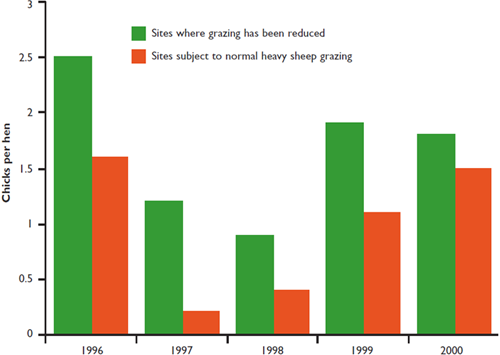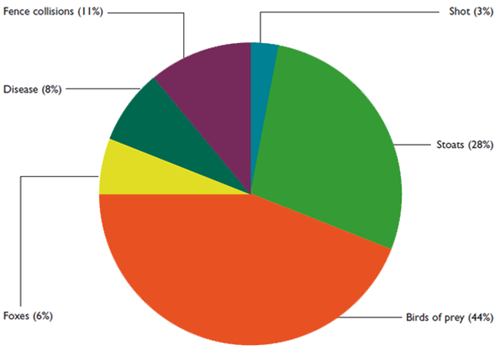Restoring the landscape
Heather moorland forms the central ribbon of habitat along which the important transition zones frequented by black grouse need to be conserved.
- Forestry plantations should have feathered edges where they abut moorland. Berried shrubs, and trees like birch, willow and rowan should be encouraged. Plantations themselves should be dissected with wide breaks in which shrubs can be encouraged.
- New transition zones can be created along sheltered burns and gills by allowing larger shrubs and dwarf birch to develop.
- Moor edge allotments should be managed to create a diverse sward of heather, bilberry, rush and grasses.
- In-bye fields along the lower moor edge need special attention. Wet rushy fields and unimproved hay meadows are important. Pastures should not be heavily stocked and some small arable plots can be used by black grouse.

Plans for a re-designed forest edge at Catterick Camp with black grouse in mind.
Rebuilding the habitat
One of the main symptoms of our declining black grouse populations has been their poor breeding success and the number of chicks reaching maturity is insufficient to maintain numbers. Although poor summer weather can exacerbate this there are number of things that can be done to improve success.
- Improve hen nutrition: In the weeks before egg-laying, greyhens need food rich in protein and energy. They also need to lay down fat for incubation. Herbs from in-bye fields, flowering cotton grass, and the buds of larch, birch and willow should be available.
- Improve insect abundance: Young chicks foraging with the hen need to consume insects at a rapid rate. Caterpillars and sawfly larvae are important foods as are ants in pine forest fringe habitats in Scotland. Experiments show that restricting grazing may be the key to improving insect abundance in some areas.
- Provide cover: Nesting hens need good shrubby ground cover for nest sites and with their young broods they like to forage among tall grass stems and low shrubs. This hides them from predators.
- Reduce predation pressure: Losses to predators can be crucial in some areas. Foxes, crows and stoats are significant predators in the breeding season and predator control may be appropriate.
Issues of habitat quality:
- Red deer: In the Scottish Highlands large numbers of browsing deer can deplete the forest shrub layer and deprive black grouse of cover and food.
- Sheep: Heavy grazing, especially along the lower edge of the moor, not only erodes the heather line, but it produces a short turf without the cover and food of tall grasses and herbs.

Reducing grazing pressure improves breeding success. Numbers of chicks per hen
at experimental sites in the North Pennines.
- Drainage: Bogs are ecological assets on any moor and should be retained as should in-bye rushy pastures.
- Meadow and pasture management: Black grouse like shoots, flowers, and seed heads, which are all abundant in old-fashioned hay meadows. Fertiliser and herbicide turn a meadow into a thick grass sward unsuited to black grouse.
- Forestry: The early stages of a plantation are ideal for black grouse as the native heath flourishes in the absence of grazing stock. By the thicket stage the grouse are gone and fence lines increase mortality.
- Pheasants: Releasing hand-reared pheasants or red-legged partridges along the moorland fringe, although a useful adjunct to shoot finances, could displace black grouse.
Increasing adult survival
This needs to be approached in two ways. Where there is an existing game shooting interest, as on a grouse moor, black grouse survival will improve if the gamekeeper undertakes a systematic predator control programme for red grouse. Where a professional gamekeeper is not operating, predator control is much more problematic. A half-hearted approach to predator control is usually a waste of time and most effort should go into habitat improvement.

The causes of 37 black grouse deaths in the Pennines, monitored by radio-tracking. Most of
this population is on a well keepered grouse moor thus fence collisions and mortality to
foxes are probably lower than they would be in the Scottish Highlands.
Gamekeepers aim to boost red grouse numbers by patchwork heather burning and controlling predation. Black grouse benefit from this. Losses to predators are most serious during the breeding season.
- Foxes: Rifle shooting at night is highly effective and, if all grouse moors in a region are vigilant, fox numbers can be kept down over a wide area. Snares, traps and flushing with dogs (up to two) to waiting guns are also used.
- Stoats: A network of tunnel traps is the key to stoat control.
- Crows: Cage traps - either small, movable Larsen traps or big, permanent crow cages - are used in the spring and early summer.
- Birds of prey: Raptors are protected and the keeper must try to reduce losses by enhancing habitat. Creating small native woodlands to provide better escape cover may improve grouse survival.